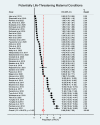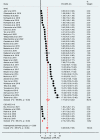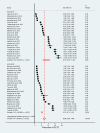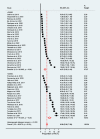Global burden of potentially life-threatening maternal conditions: a systematic review and meta-analysis
- PMID: 38166681
- PMCID: PMC10759711
- DOI: 10.1186/s12884-023-06199-9
Global burden of potentially life-threatening maternal conditions: a systematic review and meta-analysis
Abstract
Background: Potentially life-threatening maternal conditions (PLTCs) is an important proxy indicator of maternal mortality and the quality of maternal health services. It is helpful to monitor the rates of severe maternal morbidity to evaluate the quality of maternal care, particularly in low- and lower-middle-income countries. This study aims to systematically identify and synthesize available evidence on PLTCs.
Methods: We searched studies in English from 2009‒2023 in PubMed, the National Library of Medicine (NLM) Gateway, the POPLINE database, and the Science Direct website. The study team independently reviewed the illegibility criteria of the articles. Two reviewers independently appraised the included articles using the Joanna Briggs Instrument for observational studies. Disputes between the reviewers were resolved by consensus with a third reviewer. Meta-analysis was conducted in Stata version 16. The pooled proportion of PLTCs was calculated using the random effects model. The heterogeneity test was performed using the Cochrane Q test, and its level was determined using the I2 statistical result. Using Egger's test, the publication bias was assessed.
Result: Thirty-two cross-sectional, five case-control, and seven cohort studies published from 2009 to 2023 were included in the meta-analysis. The highest proportion of PLTC was 17.55% (95% CI: 15.51, 19.79) in Ethiopia, and the lowest was 0.83% (95% CI: 0.73, 0.95) in Iraq. The pooled proportion of PLTC was 6.98% (95% CI: 5.98-7.98). In the subgroup analysis, the pooled prevalence varied based on country income level: in low-income 13.44% (95% CI: 11.88-15.00) I2 = 89.90%, low-middle income 7.42% (95% CI: 5.99-8.86) I2 = 99.71%, upper-middle income 6.35% (95% CI: 4.21-8.50) I2 = 99.92%, and high-income 2.67% (95% CI: 2.34-2.99) I2 = 99.57%. Similarly, it varied based on the diagnosis criteria; WHO diagnosis criteria used 7.77% (95% CI: 6.10-9.44) I2 = 99.96% at P = 0.00, while the Centers for Disease Controls (CDC) diagnosis criteria used 2.19% (95% CI: 1.89-2.50) I2 = 99.41% at P = 0.00.
Conclusion: The pooled prevalence of PLTC is high globally, predominantly in low-income countries. The large disparity of potentially life-threatening conditions among different areas needs targeted intervention, particularly for women residing in low-income countries. The WHO diagnosis criteria minimize the underreporting of severe maternal morbidity.
Trial registration: CRD42023409229.
Keywords: Meta-analysis; Potential life-threatening; Severe maternal morbidity.
© 2024. The Author(s).
Conflict of interest statement
The authors declare no competing interests.
Figures







Similar articles
-
Determinants of potential life-threatening maternal conditions (PLTCs) in Tigray, northern Ethiopia: a case‒control study.Sci Rep. 2024 Dec 3;14(1):30022. doi: 10.1038/s41598-024-81415-w. Sci Rep. 2024. PMID: 39627408 Free PMC article.
-
Women decision-making autonomy on maternal health service and associated factors in low- and middle-income countries: Systematic review and meta-analysis.Womens Health (Lond). 2022 Jan-Dec;18:17455057221122618. doi: 10.1177/17455057221122618. Womens Health (Lond). 2022. PMID: 36062751 Free PMC article.
-
Magnitude of postpartum hemorrhage and its associated factors in Ethiopia: a systematic review and meta-analysis.Reprod Health. 2022 Mar 9;19(1):63. doi: 10.1186/s12978-022-01360-7. Reprod Health. 2022. PMID: 35264188 Free PMC article.
-
Mortality and its association with CD4 cell count and hemoglobin level among children on antiretroviral therapy in Ethiopia: a systematic review and meta-analysis.Trop Med Health. 2020 Sep 21;48:80. doi: 10.1186/s41182-020-00267-y. eCollection 2020. Trop Med Health. 2020. PMID: 32973396 Free PMC article.
-
The prevalence of respectful maternity care during childbirth and its determinants in Ethiopia: A systematic review and meta-analysis.PLoS One. 2022 Nov 23;17(11):e0277889. doi: 10.1371/journal.pone.0277889. eCollection 2022. PLoS One. 2022. PMID: 36417397 Free PMC article.
Cited by
-
Determinants of potential life-threatening maternal conditions (PLTCs) in Tigray, northern Ethiopia: a case‒control study.Sci Rep. 2024 Dec 3;14(1):30022. doi: 10.1038/s41598-024-81415-w. Sci Rep. 2024. PMID: 39627408 Free PMC article.
-
Healthcare-Seeking Behaviour for Obstetric Complications in Ethiopia: A Multilevel Mixed-Effect Analysis.Health Serv Insights. 2025 Jun 24;18:11786329251347353. doi: 10.1177/11786329251347353. eCollection 2025. Health Serv Insights. 2025. PMID: 40567355 Free PMC article.
References
-
- Cecatti JG, Souza JP, Parpinelli MA, Haddad SM, Camargo RS, Pacagnella RC, et al. Brazilian network for the surveillance of maternal potentially life-threatening morbidity and maternal near-miss and a multidimensional evaluation of their long-term consequences. Reprod Health. 2009;6(1):1–10. doi: 10.1186/1742-4755-6-15. - DOI - PMC - PubMed
-
- World Health Organization. Trends in maternal mortality 2000 to 2017: estimates by WHO, UNICEF, UNFPA, World Bank Group and the United Nations Population Division. Sexual and Reproductive Health. 2019. 12 p. Available from: https://www.who.int/reproductivehealth/publications/maternal-mortality-2....
Publication types
MeSH terms
LinkOut - more resources
Full Text Sources

